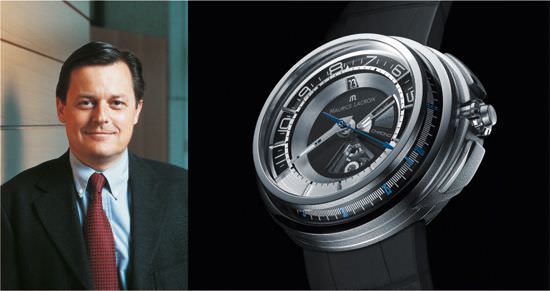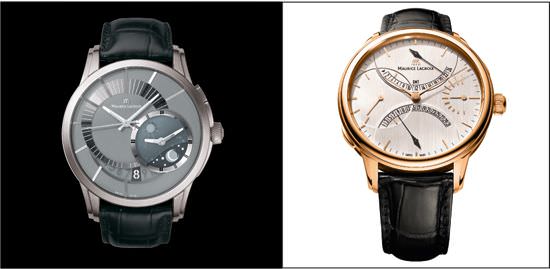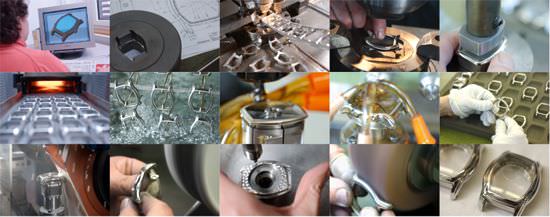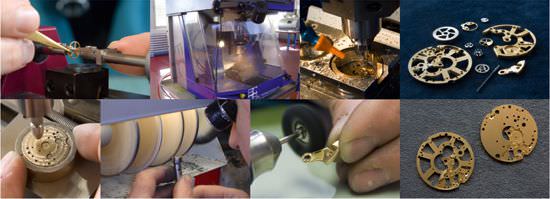The industrial adventure started by Maurice Lacroix under the direction of Philippe Merk is beginning to bear fruit, thus confirming the sagacity of the strategy put in place by the brand’s CEO, a scientist by training who then went on to get an MBA. To meet the affable and enthusiastic Philippe Merk, Europa Star travelled to SaignelÉgier in the Swiss Jura Mountains, where most of the facilities of the growing brand are located. For our readers, Merk offers his insights into the watch industry and discusses the long-term goals of his Zurich-based independent brand.

Philippe Merk and the spectacular MÉMOIRE 1
Europa Star: Your strategy seems to be increasingly visible. We have noticed this over the last few years, not only in the obvious move up-market for Maurice Lacroix watches, but also in the clarification of the brand’s stylistic identity. Today, we are also seeing the brand’s determination to assure a certain industrial independence. Where are you in this process?
Philippe Merk: As you have seen during your visit [Editor’s Note: see sidebar], Maurice Lacroix is now at the head of a growing and important industrial structure. This not only includes the heart of our activity, with our very large ateliers devoted to assembly, control, and logistics, but it also houses our case manufacturer, Queloz, that we have owned since 1999. Queloz’s production has evolved from fabricating mid-range cases to now creating sophisticated and prestige cases. We also have a facility called Manufacture des Franches-Montagnes—MFM—created from the ground up in only one and a half years. Here, we make component parts for movements with high added value. In addition, we also have our research and development laboratories, our constructors, and a special Atelier devoted essentially, for the moment, to the famous Mémoire 1.
Queloz, like MFM, not only manufactures for Maurice Lacroix but for other brands as well. It has an excellent portfolio of first quality external brands and, to tell the truth, we have almost too many orders. MFM is also looking for clients and is beginning to form excellent relationships with outside brands. Fundamentally, our goal is to work with independent brands in the haut de gamme sector.
I firmly believe that independent brands, whose turnover accounts for about 25 percent of the total turnover of Swiss watchmaking, would benefit by strengthening their cooperation and developing synergies in order to preserve the philosophy of independence. By working together, we can all improve. While we gradually integrate our new skills, we also take care to maintain close relationships with a wide network of suppliers, principally in the Jurassic Arc region. We are also investing a considerable amount of money in our production tools. This is the price of our independence.
ES: The price of this independence is indeed high. Does the brand’s owner, Desco, have the means to see this through?
Ph.M.: Historically, Desco was a large international trading company. Today, it is Maurice Lacroix, period! Desco has divested itself of all other activities. It also recently sold its distribution in Asia to the powerful DKSH group—Diethelm Keller Sieber Hegner—that employs 25,000 people and has a turnover of 6 billion Swiss francs. DKSH is also in the Asian markets and competes with the large watch groups. We still, however, maintain our own distribution in Europe. From now on, the situation is clear. Over the next five years, we won’t depart from our strategy; we will remain faithful to our product line and we will conserve our independence. We have the means to support these goals.

PONTOS DECENTRIQUE GMT, MASTERPIECE DOUBLE RETROGRADE LIMITED EDITION
ES: How many watches do you produce?
Ph.M.: Today, Maurice Lacroix produces 100,000 pieces a year, of which 50 percent are mechanical watches. By 2012, we want to decrease this amount to a total of 60,000 watches, which will essentially be all mechanical. Little by little, quartz will disappear from our product offer and the ratio of in-house movements to purchased movements (primarily ETA or ETA-compatible) will be in favour, obviously, of our own movements. We still have watches today with prices of 1,000 Swiss francs. Over time, however, the Masterpiece, with prices between 5,000 and 8,000 Swiss francs, will represent 80 percent of our offer. Our more overtly contemporary collection, Pontos, proposes models ranging from 2,500 to 8,000 Swiss francs for 80 percent of the collection. We are going to focus on these two lines and our image is clear—crystal clear.
ES: Regarding your image, we have the impression that an identity is being established because of a style that is being asserted.
Ph.M.: We have transformed, and continue to transform, our identity. This transformation began with the Masterpiece five or six years ago and then accelerated three years ago with our decision to heavily invest in our manufacturing facilities. It is a process that we follow and will progressively intensify. Maurice Lacroix’s new positioning was immediately, and very positively, noticed in the United States and in Asia where interest in the brand has grown quite rapidly. This change has been more difficult in Europe, that is true, especially in Germany—traditionally a large market for us—because we started with a lower image.
To change this image is a complicated challenge, one that has passionately stirred our teams into action. We will succeed. Obviously, this concerns our distribution. In Germany, for example, we decreased the number of our sales points from 1400 in 2001 to 600 now. In 2001, we were present in 30 markets. Today, we are active in 70 countries, and some regions are only in the beginning stages. The Middle East and South America offer huge potential for development. Russia is emerging at a rapid pace. In fresh markets, we can assert our new identity, with no past issues to contend with.

MASTERPIECE LE CHRONOGRAPHE – ML 106 CALIBRE
Maurice Lacroix’s first own manufacture mechanical movement, hand-decorated, hand-wound chronograph with 60-minute counter and small seconds. 20 jewels, blued steel screws, two gold 18-carat gold chatons, column wheel, swan neck precision adjustment, KIF shock protection, polished steel pallet and escapement wheel, Glucydur coiled balance wheel and 18,000 a/h.
MASTERPIECE SQUELETTE – ML 134 CALLIBRE
Maurice Lacroix manufacture skeleton movement, hand-decorated, hand-wound mechanical movement with hours and minutes indication with central hands and small seconds. 17 jewels, bridges and screws with PVD surface refinement in tantalum colour or black, polished steel pallet and escapement wheel, Glucydur coiled balance wheel, Incabloc shock protection and 18,000 a/h.
MASTERPIECE DOUBLE RETROGRADE LIMITED VERSION – ML 151 CALIBRE
Maurice Lacroix manufacture movement, hand-decorated mechanical movement with hours and minutes indication with central hands, retrograde 24-hour indication for second time zone, retrograde date indication, power reserve indication and small seconds. 52 jewels, bridges ball-peened and pink gold plated, polished steel screws, 3/4 bridge engraved as limited edition, blued steel screws and 18,000 a/h.
ES: In this process that you describe, does the Mémoire 1 play a particular role?
Ph.M.: Yes, of course. It plays a key role. It is a demonstration of our watchmaking authen-ticity obtained after a great deal of effort. The Mémoire 1, with its totally unique complication and its special design [Editor’s Note: see article in Europa Star 2.08], is a bold timepiece, of which opinions are divided. So much the better! This has allowed our teams to progress rapidly. Our technology and patented mechanical memory system were developed because of this timepiece. This opens a very vast area that we can now explore. In addition, most of the component parts—60 percent—were designed and fabricated by our own teams in the Atelier, working in collaboration with the most highly advanced experts.
With its 600 components, the piece is so complex, in terms of friction and the forces brought into play, that we were not able to simulate it on a computer. We thus had to test everything in the Atelier, the same workshop where the 20 models of the Mémoire 1 will be produced in 2009. Later, the memory function will be integrated into the Masterpiece collection, but in a different and simpler form, and with a different movement. As for this special Atelier, it will continue to explore avenues for new and exceptional timepieces. Time will come for the Mémoire 2. . .
ES: In today’s fiercely competitive environment where every brand worthy of the name wants to have an exceptional piece and make itself known, can Maurice Lacroix bring something to the table that the others cannot?
Ph.M.: Yes. The Mémoire 1 is already a demonstration of this. It shows an approach that operates perhaps with less inhibitions than other brands that are genetically more constrained. Our past as a mid-range brand has forced us to be more attentive to the needs of the consumer, while other more institutionalized brands tend to focus more on the offer. We have thus learned to take into consideration what the final consumer is looking for.
Focusing on the customer is also why we pay particular attention to the notion of display. It is not by chance that our dials—the faces of our watches—are especially known for their beauty and readability. It is our own DNA that we use in making this happen. Some say that Swiss watchmaking, with its 14 billion Swiss francs of exports, is at the summit. But what does this sum actually represent in the global scheme of things? It is only a drop in the ocean. The potential for growth is enormous.
At the present time, our goals are to succeed in communicating our values, properly forming our distribution network and developing loyal relationships. I cannot be satisfied with the logistical chain, in the broad sense of the term, of Swiss timekeeping such as it operates today. There is much to do in increasing the prestige of watchmaking, its products, its skills, and its complexity. Working on these elements is also part of building a brand.
MAURICE LACROIX’S PRIMARY INDUSTRIAL PRODUCTION UNITS
The three main production units of Maurice Lacroix are all located in or near Saignelégier, and are 100 percent owned by Desco Holding.

Queloz
Established in 1937 and purchased by Desco in 1999, Queloz is a manufacturer of cases and employs 70 people. Production is oriented mainly towards the haut de gamme sector with cases in gold, platinum, titanium, and steel. The company produces the entire line of cases in the Masterpiece collection and also works for a number of other large independent watch brands in the haut de gamme sector. Among its ateliers are those involved in stamping, soldering, turning, threading, CNC five-axe 12-tool milling, machine-gunning, hand finishing (burring, tapping, circular graining), sanding, diamond polishing, drilling, polishing, stone setting and case assembly.

Manufacture des Franches-Montagnes (MFM)
Created in 2006, this small yet high performing manufacturing facility employs 12 people and specializes in cutting bridges, plates, pinions, and milling (especially for skeleton movements) as well as in finishing (circular graining, chamfering, line drawing, and soon, the CÔtes de Genève pattern). Focused on production of small series with high added value, MFM specializes in the most sought after component parts: column wheels, barrel shafts, cannon-pinion wheels, etc. MFM also works with outside clients.

Maurice Lacroix factory
Renovated and enlarged, this imposing building groups together the units for assembly, control, and logistics that are necessary for the production of 100,000 watches a year. From pre-assembly, hand-assembly, or mass-produced assembly according to the type of movement (Maurice Lacroix has four in-house movements: chronograph, skeleton, retrograde, and double retrograde), to final assembly, highly developed control units, stocks of supplies (500,000 components in stock for 6,000 models), and logistics, all production is organized as a direct flow between the movement assembly and the final assembly. This building also houses a large research and development department, a movement construction site, as well as the Atelier, a unit specialized in complex movements (currently the Mémoire 1).
Source: Europa Star August-September 2008 Magazine Issue




